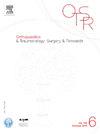MRI analysis of the chondral surface following deepening trochleoplasty for patellofemoral instability
IF 2.2
3区 医学
Q2 ORTHOPEDICS
引用次数: 0
Abstract
Background
The incidence of patellofemoral instability is 5.8 per 100,000 in the general population, rising to 29–43 per 100,000 in adolescents. Up to 85% of recurrent instability is associated with trochlea dysplasia. The Dejour sulcus deepening trochleoplasty can be used to effectively treat patellofemoral instability, however the effect on patellofemoral cartilage and survival of the osteochondral flap is not known. The aim of the study was to determine changes in the patellofemoral articular surface in the early postoperative period with MRI analysis.
Patients and methods
MRI analysis of a single-surgeon series, retrospective review of 61 sulcus deepening trochleoplasties between 2014 and 2022, of which 40 had a postoperative MRI and were assessed – including 26 women (65%) and 22 (55%) right knees. Trochleoplasty was performed in conjunction with medial reefing and lateral release in 26 patients (65%), in conjunction with MPFL reconstruction alone in 12 (30%), and in conjunction with MPFL reconstruction and tibial tubercle osteotomy in 2 (5%). Preoperative and postoperative MRIs were assessed for articular cartilage loss, percentage of full thickness cartilage loss as well as volume and number of bone marrow lesions using a modified version of the MRI osteoarthritis knee score (MOAKS).
Results
Mean age at operation was 25.3 years (SD: 7.3). The modal number of comorbidities was zero, and no patient had diabetes or was taking immunosuppressive medication. Mean time between preoperative MRI and trochleoplasty was 8.7 months (SD: 6.9). Mean time between trochleoplasty and postoperative MRI was 19.9 months (SD 14.9). There were further episodes of symptomatic instability in 8 (20%) of patients. In all anatomical subregions (medial and lateral patellar, medial and lateral trochlear groove) there was a significant increase in articular cartilage loss between pre- and post-operative MRIs (p < 0.001). There was a significant decrease in the volume and number of bone marrow lesions (BMLs) in the medial patella only, with static or nonsignificant increases in the lateral patella and medial trochlear groove, and significant increases in the number and volume of BMLs in the lateral trochlea (p < 0.001). MOAK grade 1 was seen in at least one anatomical subregion in every patient post-operatively and there was progression in MOAK grade in all subregions. Progression in MOAK grade was seen in the medial patella in 20 patients (50%), lateral patella in 18 patients (45%), medial trochlea in 22 patients (45%) and lateral trochlea in 31 patients (78%).
Discussion and conclusion
Whilst patellofemoral osteoarthritis is common post trochleoplasty, the history of its development is not clear. Few studies report cartilage condition post-surgery. Authors in the only other MRI study found no change in cartilage condition at a mean of 64-months. A small case series of histological samples taken from trochleoplasty patients during subsequent arthroscopy also found normal cartilage and a healing osteochondral flap. Our study evaluated the entire patellofemoral surface using MRI and found that patellofemoral articular cartilage loss was seen in at least one anatomical subregion in every patient post-operatively, with progression in chondral damage seen in between 45% and 78% of anatomical subregions.
Level of evidence
IV; observational cohort study
髌股不稳股骨滑车加深成形术后软骨表面的MRI分析。
背景:一般人群髌骨不稳的发生率为每10万人5.8例,青少年上升至每10万人29-43例。高达85%的复发性不稳定与滑车发育不良有关。Dejour沟加深滑车成形术可有效治疗髌股不稳,但对髌股软骨和骨软骨瓣存活的影响尚不清楚。该研究的目的是通过MRI分析确定术后早期髌股关节面变化。患者和方法:对单个外科医生的MRI分析,回顾性分析2014年至2022年间61例沟加深滑车成形术,其中40例进行了术后MRI检查,包括26例女性(65%)和22例右膝(55%)。26例(65%)患者行滑车成形术,同时行内侧复位和外侧松解术,12例(30%)患者单独行MPFL重建,2例(5%)患者同时行MPFL重建和胫骨结节截骨术。术前和术后MRI使用改良版的MRI骨关节炎膝关节评分(MOAKS)评估关节软骨损失、全层软骨损失百分比以及骨髓病变的体积和数量。结果:平均手术年龄25.3岁(SD: 7.3)。合并症的模态数为零,没有患者患有糖尿病或正在服用免疫抑制药物。术前MRI和滑车成形术之间的平均时间为8.7个月(SD: 6.9)。从滑车成形术到术后MRI的平均时间为19.9个月(SD 14.9)。8例(20%)患者出现症状不稳定的进一步发作。在所有解剖亚区(髌骨内侧和外侧,滑车沟内侧和外侧)中,术前和术后mri中关节软骨损失显著增加(p讨论和结论:虽然髌股骨关节炎是滑车成形术后常见的,但其发展历史尚不清楚。很少有研究报道术后软骨状况。另一项MRI研究的作者发现,平均64个月后软骨状况没有变化。在随后的关节镜检查中,从滑骨成形术患者身上采集的组织学样本也发现了正常的软骨和愈合的骨软骨瓣。我们的研究使用MRI评估了整个髌骨股表面,发现每位患者术后至少有一个解剖亚区可见髌骨股关节软骨丢失,在45%至78%的解剖亚区可见软骨损伤进展。证据等级:四级;观察性队列研究。
本文章由计算机程序翻译,如有差异,请以英文原文为准。
求助全文
约1分钟内获得全文
求助全文
来源期刊
CiteScore
5.10
自引率
26.10%
发文量
329
审稿时长
12.5 weeks
期刊介绍:
Orthopaedics & Traumatology: Surgery & Research (OTSR) publishes original scientific work in English related to all domains of orthopaedics. Original articles, Reviews, Technical notes and Concise follow-up of a former OTSR study are published in English in electronic form only and indexed in the main international databases.

 求助内容:
求助内容: 应助结果提醒方式:
应助结果提醒方式:


